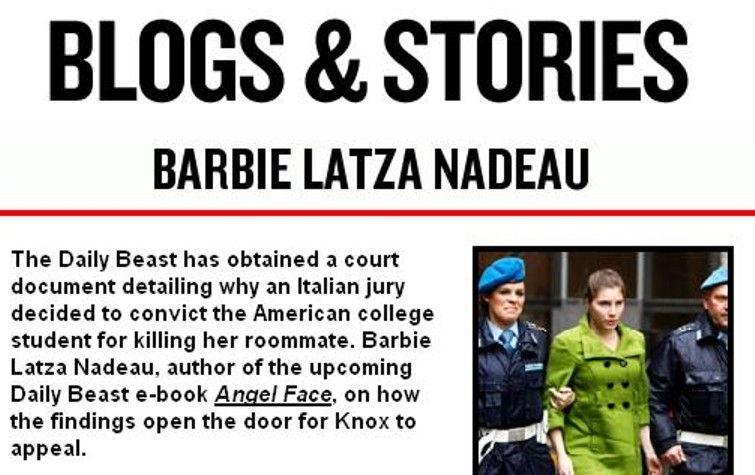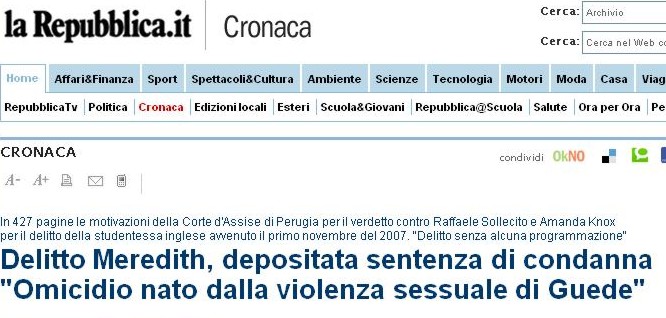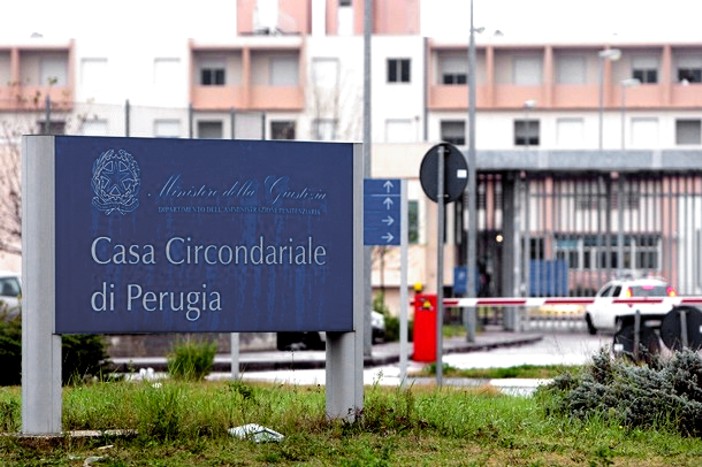
Category: Excellent reporting
Sunday, May 30, 2010
Questions For Knox And Sollecito: Ten From Daily Beast As Knox Calunnia #2 Trial Starts
Posted by Peter Quennell

This Daily Beast report indicates that the cancelled jailhouse TV interview with Amanda Knox was a lot more firmed-up than Knox’s stepfather, Chris Mellas, seems to have claimed.
And it outlines the first phase of Knox’s Calunnia #2 trial which is based on charges brought by the interrogating police, all of whom testified at her trial that she was treated well during her interrogations as a witness and suspect. .
Click the image or link above above for the fine reporter Barbie Nadeau’s full article on some issues Knox has never been able to account for, including Knox’s callous skipping of Meredith’s memorial service.
The ten questions are all very tough, and each would also have been asked by the jury. Here they are:
.:
It’s back to court for Amanda Knox, the 22-year-old Seattle native currently serving 26 years in prison in Italy for sexually assaulting and murdering her British roommate, Meredith Kercher.
This week, Knox is expected to attend a preliminary hearing on slander charges lodged against her for accusing Perugia police of abuse. During her testimony at her murder trial last June, she accused the cops of slapping her on the back of the head during an interrogation just days after Kercher’s body was discovered in November 2007.
The police deny hitting her, and Knox’s own lawyers have never filed charges for the alleged abuse. If she is convicted of slander, a judge could add six years to her sentence….
Knox’s resurgence in the headlines was to coincide with a joint jailhouse interview she had granted to ABC News and the Italian broadcaster Mediaset’s Matrix program. But the bureau of prisons denied the interview in the final hour, effectively silencing Knox indefinitely.
A high-profile jailhouse interview with Knox is considered the Holy Grail by journalists covering the case, and the American and Italian networks have been vying for a chance to ask Knox a few questions on camera. Now it is unlikely anyone will get an interview before Knox’s appeal hearings this fall.
But if we did, there are a few questions we’d want her to put to rest.
1. Why did you and Raffaele Sollecito turn off your cell phones at the same time the night of November 1, 2007 and on again at the same time the next morning? You told the police that you and Raffaele slept late the morning of November 2, 2007, but phone records show that you both turned your phones back on very early that morning. How could that be?
2. Why were you bleeding? Your lawyers agree with the prosecution’s findings that at least one of the spots of Meredith’s blood found in the house where she was killed had your blood mixed with it. Your mother told me that you had your period. Your stepfather told others that your ear piercings were infected. Which was it?
3. Once you realized your mistake in blaming Patrick Lumumba for Meredith’s murder, why didn’t you tell the authorities? You told your mother that you felt bad about it, so why didn’t you alert an official so Patrick could be set free?
4. Why did you go with Raffaele to the police station on November 5? You were not called in for questioning. Did you realize at that time that you were both under suspicion?
5. Why weren’t your and Raffaele’s fingerprints found in your house after the murder if the two of you had spent time there that morning and the day before? Only one half-print on a glass in the kitchen has been attributed to you, yet you have claimed that you took a shower there that morning. How did you spend so much time there and leave virtually no trace?
6. Why did you take the mop and bucket from your house over to Raffaele’s house? You told the prosecutor during your testimony in June 2009 that you took the mop and bucket to his house to clean up a leak under his kitchen sink. But by your own testimony, the leak was miniscule and could have been easily cleaned up without it. What were you really doing with the mop?
7. What would you do differently if you had a chance to rewind the clock back to November 3, 2007? Would you go to the memorial service for Meredith? Would you still have gone to the police station with Raffaele? Would you have left for Germany when your aunt asked you to?
8. What do you think happened the night Meredith was killed? You have professed your innocence. Who do you think killed her and under what circumstances?
9. What do you really think of the Italian justice system? You told an Italian parliamentarian that you got a fair trial, and you even thanked the prosecutors for trying to solve the mystery of Meredith’s death, but your supporters at home in Seattle maintain that the Italian system is corrupt and unfair. What is your real view?
10. Is there anything you wish you would have said in court during your trial? You talked about your vibrator and about how you did not want an assassin’s mask forced on you. But in your final appeal after the closing arguments on December 4, 2010, why didn’t you say the words, “I did not kill Meredith Kercher?” Raffaele did when it was his turn to speak. Why didn’t you?
Our posting soon of the judges’ sentencing report will open up dozens of new questions for Knox. Such as: “How did you track Meredith’s blood into your own room and leave three traces revealed by luminol?”
Tuesday, May 04, 2010
From The Book Darkness Descending: The Insights On Rudy Guede
Posted by Peter Quennell
Above and just below: Abidjan, the very attractive West African city where Rudy Guede was born and where he lived until he was five.
Darkness Descending includes this well-researched and revealing portrait below of Rudy Guede and the two traumatic experiences that really threw him: his moving in with the Caporali family, and the collapse of the restaurant in northern Italy which briefly employed him.
No claims here about Rudy Guede being a drifter or drug-dealer or dangerous knife-wielder or petty criminal.
None of those things are confirmed by the record or the Micheli report, and few or none in Perugia or Italy generally seem to believe Rudy Guede was the sole perpetrator or even the main perpetrator of Meredith’s death.

(Above: the downtown of Abidjan, the economic and former political capital of the Ivory Coast)
From Darkness Descending by Paul Russell and Graham Johnson (Pocket Books) pages 292 to 296
Unlike Amanda and Raffaele, the background of Rudy Hermann Guede seemed to inspire a degree of sympathy in readers and viewers.
At least once the undercurrents of reactionary racism had run its course and readers were able to identify with Guede the individual.
Guede had been dragged up a virtual orphan. He seemed to be luckless, directionless, prone to following others into trouble, his carers said. He’d never had a paternal figure to look up to or guide him.
That, and the fact that once he’d been caught he seemed to be at least trying to tell the truth about his involvement with Meredith, gave him a certain credibility.
He was often given a fair hearing in the papers for not trying to evade guilt by changing his story. Editors and readers seemed to appreciate that he had not relied on high-powered family connections to duck out of one of the most tragic cases that had ever come before them.

(From Piazza Italia at the south end of the walled city - Rudy Guede first lived off there to the south-east)
Guede came to Italy in 1992, when he was five years old. His father Roger had emigrated from the Ivory Coast a few years before at a time when the Italian economy needed new manpower to fuel the country’s post-industrial boom…
Roger Guede had trained as a teacher in the former capital city of the Ivory Coast, Abidjan, where his wife still lived with little Rudy, but in Italy he found work as a bricklayer.
Life was hard because of exploitation, denial of workers’ basic rights and rampant illegal labour.
After five years he was granted a regular resident’s permit and returned to Abidjan to his wife, to see if he could take the young Rudy back to Italy with him. She agreed that in Italy he would have a chance of a better life.
Roger and Rudy found a flat in the shabby low-lying suburb of Perugia called Ponte San Giovanni. The neighbourhood was not at the top of the hill, with its wide vistas, ancient buildings and air of academia.
Roger’s life had no room for aspiration or fanciful gap-year adventures. He settled for a seedy new-build on the valley floor near the railway station. An unhealthy stream meandered through the projects like a sewer.
Still, it was better than the shanty town where Rudy’s mother was eking out a bare existence.
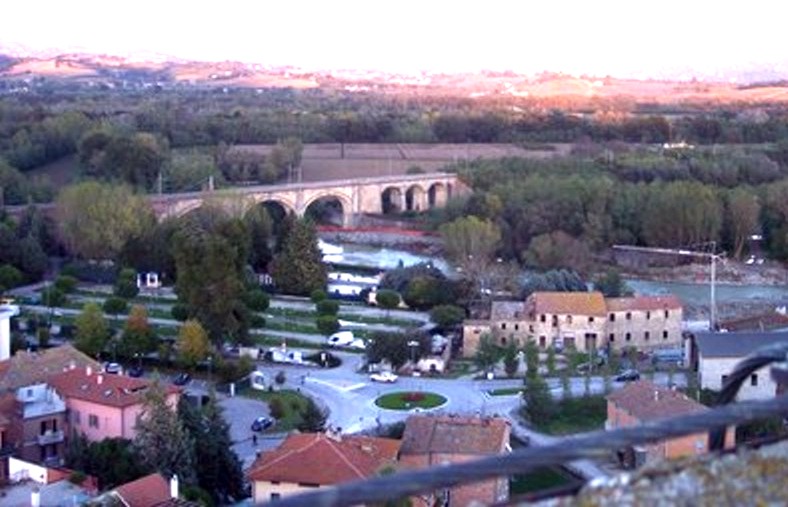
[Shots here and just below of Ponte San Giovanni, the town just to the east where Guede first lived]
New to immigration, Italy’s attitude to race relations has often been schizophrenic. Far-right extremists have been known to whip up dissension. But in Perugia, a small community like many that made up the backbone of Italian society, Roger and his son were welcomed.
His presence stimulated the lively cutiosity of Italians, not their hostility. The kindness of his neighbours and the willingness of social services to offer him childcare were proof of that, and he was free to hit the road to find building-site work.
During these absences Rudy was fostered by local families. One of his first full-time carers was a Mrs Mancini, who had been his maths teacher at school. She never lost interest in him and was to be like a second mother.
Rudy also struck up a lifelong friendship with her son Gabriele and another schoolmate, Giacomo Benedetti. The fabric of a closeknit Italian working-class community felt like a protective cloak and Rudy thrived.
His teachers and foster families all say that he was a quiet child, well behaved and responsible. He had moments of daydreaming stupidity, but no more than other kids.
He was good at basketball - tall, athletic and serious. The local professional basketball team was sponsored by one of Italy’s most successful companies, Liomatic, who manufactured coffee dispensers - a link that would later change the course of his life.
One day, Rudy’s dad went home to Abidjan to renew his passport, but civil war broke out when he was in the country and instead of spending two weeks away from his son he was trapped for six months, as strife raged in the Ivory Coast.
Back in Italy, the social services stepped in with a view to formalizing Rudy’s foster status and finding a long-term home for him.
Rudy was unhappy but he coped with the loneliness and uncertainty with admirable courage. He didn’t complain. And he was soon rewarded. Astonishingly, he was catapulted into the heart of one of Italy’s richest families.

[Another shot of Ponte San Giovanni, where Guede in his early days apparently lived happily]
His change of fortune was like something out of the plot of the musical Annie. Rudy had met one of the Caporali sons at basketball. Now the family wanted to officially take him in as one of their own. He never lived with Roger again.
The change wasn’t smooth. Rudy found it difficult to adapt. When he moved out of Ponte San Giovanni, he lost touch with many of his old friends, which he found particularly hard.
They had been the bedrock in what had so far been a rather unstable family life. He soon missed the informality, the lack of pressure to succeed and the maternal bonds that Italian families are famous for.
It wasn’t long before his new father figure, Paolo Caporali, was calling Rudy ‘an inveterate liar’. He skipped school and spent his time in front of the television or on PlayStation. Caporali’s wife and kids were much kinder in their view:
Rudy was introverted and shy. He lied to protect himself, but not maliciously to hurt others or gain personal advantage.
The move from a poor area to the home of the super-rich Caporali family had confused Rudy and, to some degree, had embarrassed him.
His basketball trainer Roberto Segolini said Rudy was friends with everyone and never missed a training session. Where he could prove his worth and show success to his new high-status family, Rudy thrived.
With such a chequered school career, Rudy would find it hard to find a job that suited him once he left school. But at the age of nineteen he went to stay with an aunt in Lecco and landed a job as a waiter in Pavia.

[Shot of Lecco north of Milan where at age 19 Rudy Guede moved to live with an aunt]
Finally, he had found his way. He was ecstatic. He was now going to prove that he could knuckle down and stand on his own two feet. He thought about learning the trade and one day opening a restaurant.
But as soon as he settled in, the rug was pulled from under him - his employer was arrested and the business folded.
To someone with a fragile view of himself, this chance setback took on a great and doom-laden significance. Rudy blamed himself and worried about how he would explain his bad luck to the Caporalis.

[Shot of Pavia south of Milan where Rudy Guede worked as a waiter till the restaurant collapsed]
Confidence shattered, he fled back to Perugia in shame. It was July 2007 and the beginning of the long summer that would end in tragedy.
The Caporalis were desperate to bolster his self-esteem. In August they found him a gardener’s job at a restaurant they owned out of town.
He stayed with the Mancinis, where the father and mother made sure he got up early to catch the bus. But the rot had set in; he wanted to live where the excitement was.
He was distracted by the scallywag antics of the lads in Perugia, who never seemed to work but always had money, and by the beautiful students from allover the world who were descending on the University to find digs and party.
Amanda and Meredith would be among them. Once he failed to go to work for a whole week, claiming he had flu and snivelling unconvincingly over the phone. He was sacked.
He lived off his savings until 2 November, when the murder and his doomed getaway would end any hopes he had of turning his life around.

[Shot of Mainz on the Rhine between Frankfurt and Bonn where Rudy Guede was captured]
Monday, May 03, 2010
From The Book Darkness Descending: The Insights On Knox And Sollecito
Posted by Peter Quennell
This is Hamburg above. And that is Berlin and its parliament (the Bundestag) below.
Amanda Knox speaks German and she spent several months in these two cities, staying for some weeks in in Hamburg with her relatives, and several days in Berlin, before moving to Perugia to start her study period there.
Darkness Descending is the book on Meredith’s case by two British writers from which we excerpted on Meredith a few days ago.
As far as we know the writers did not visit Seattle, and their focus is more generally on Italy and to some extent the UK. But they did offer this brief take on Amanda Knox, and also one on Raffaele Sollecito.
**********
From Darkness Descending by Paul Russell and Graham Johnson (Pocket Books) pages 291 and 292
Meredith had enjoyed making the pop video with her University of Leeds friends, but Amanda’s summer job, before travelling around Europe and going to Perugia, had not been so successful.
A politically well-connected uncle in Hamburg had got her an internship to die for - a job working for a German MP at the Bundestag. Kindly Uncle Uwe also set Amanda up with a flat on the .outskirts of Berlin.
Astonishingly, two days later, his seemingly ungrateful niece walked out on the job without telling anyone, moaning that she had nothing to do and she wasn’t sure if she was getting paid. Again, money was a big feature in her thoughts.
She’d spent most of the time reading Harry Potter and showed no curiosity about how the parliament or the high-powered people in there worked. She ignored conversations about its history and architecture.
After walking out, she spent her time drinking wine in the local bars and reading more Harry Potter.
Two days later she left Berlin for Hamburg, where her uncle was waiting for her. He was furious - she had let him down.
It seems Amanda craved excitement on her terms, usually based on getting drunk and goofing around.
Her friends said she simply feared boredom like any young girl. She showed a healthy streak of youthful carelessness, they said, no worse or better than anyone else. A video posted on YouTube showed her drunkenly giggling in a friend’s kitchen after downing shots.
On campus, back in the US, Amanda had been fined for being drunk and disorderly at a party held in a fellow student’s house. During the incident she had also insulted the police.
However, her defenders gave another version, portraying a magnanimous Amanda. They said that in fact she was courageously fronting up for her underage friends, who were in no state to talk to the police; she was the only one sober enough to handle the situation.
A big plus in her character assessment, they said, possibly displaying a sense of chivalry that would later get her into deeper trouble in Perugia.
Despite her college party lifestyle, there was no denying that Amanda was clever and that she could compartmentalize her life.
She made the Dean’s List, an elite commendation of the University of Washington reserved for the institution’s brightest students, and an honour that would ultimately qualify her for a prestigious and sought-after place on the study-abroad exchange programme.
If Amanda wanted something, she would go all out to get it, no messing around.
Raffaele Sollecito’s later years were quite different: he seemed to laze around and evade responsibility.
He posted pictures of himself on the internet wrapped in blood-covered bandages, brandishing a meat cleaver, and wrote a weird story to go with the images. In a blog he expressed satisfaction at once being lodged in the same hostel as the infamous ‘Monster of Foligno’, a murderer who slaughtered two youths in the 1990s.
And yet his new-found fascination with gory horror and violent comics would have surprised the friends he left behind at Licea Scientifico Einstein secondary school at Molfetta.
They said Raffaele suffered from excessive softness - his kickboxing instructor recalled that he even hesitated when kicking out, for fear of hurting the hardened expert.
***********
A few interesting insights there, though we could use more on Sollecito. For most of it, this is a pretty good book, the weak part being the closing analysis of the evidence. Two small corrections.
- The house where the notorious rock-throwing party took place was where Knox herself was living at the time. See here.
- Knox was not on an official University of Washington study-abroad program, as the university has rather anxiously tried to make plain. See here.
If Knox had indeed been on a proper study-abroad program - something many caring parents actually insist upon - her behavior might have been more restrained. She may not have moved in with Sollecito for one thing.
She may not have hit the drugs so hard. And she would not have run so desperately short of money, just when Patrick was apparently about to hire Meredith to replace her. No monthly checks were arriving from Seattle.
Maybe the second correction is not such a small one.
In fact, it is a pity that no writers have really explored all of this - there is, if anything, a surfeit of motives in this case, and the writers might be able to narrow them down.
Although he went to highschool in Molfetta (bottom shot here) and the book is correct on that, Raffaele Sollecito actually comes from Giovinazzo which is ten minutes drive south along the coast.
Both are north of Bari, where his father practices medicine.
Friday, April 16, 2010
Italian Media Reporting Impartially On Prosecution Appeal Filed For Increased Sentences
Posted by Peter Quennell
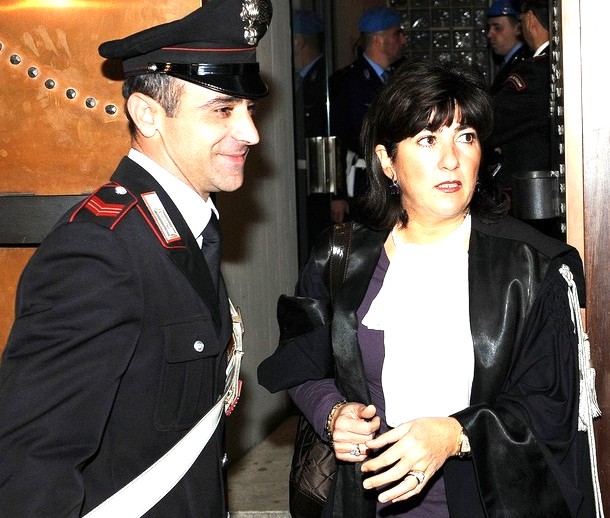
[Above: Prosecutor Manuela Comodi.]
In light of the judges’ sentencing report (due soon here and on PMF in English) the prosecution have filed an appeal that Knox’s and Sollecito’s sentences be revised upward to life.
Life sentences were their original request to the court last November, and the Italian media in November and early December largely anticipated at least 30 years. The 26 years for Knox and 25 for Sollecito came to many as a surprise.
First legal advice from the Italian lawyers on our team is that at minimum this could firm up the existing sentences, and at maximum Knox and Sollecito actually could be looking at life behind bars - such upward revisions do happen.
Remember that the Italian public are way better informed on the cruel depravity of the crime than the British or American publics.
And that Knox’s cold smug antics on the stand, during which she spoke flippantly and callously of Meredith’s passing, seemed to leave few in Italy feeling any real sympathy.
Grounds for the appeal are twofold: (1) That the judges’ arguments for the granting of extenuating circumstances was a stretch (such as the conclusion that the duvet placed over Meredith was a sign of remorse), and (2) That the judges’ dismissing of aggravating circumstances was in effect a shortfall (such as the possibility that Meredith could have been saved if they had not removed her phones, locked the door, and walked off).
The posters here and on PMF may be the largest group in the English-speaking world so far to have actually read the judges’ sentencing report.
Typically we are finding the description of the evidence to be extremely detailed and quite remorseless. There is very, very little room for argument about it, and the defense teams in the appeals will have an even tougher time laying a paw on it than they did in the course of the trial. We are highly impressed by this - this case NEEDED this to put an end to the endless myth-mongering, and to give Meredith’s family and friends hope of some respite.
But the motives assumed in the sentencing report, the judges’ timeline (which differs from both Micheli’s and Mignini’s), and the instigating role given to Rudy Guede, were interpretations the sentencing judges made which the appeals judges may not buy into.
The defense teams will not be resting any easier in light of this. The pressures may be mounting for the lawyers and defendants to finally split three ways - we will have a major post next week on their three-way herding of one another over the past two-plus years.
And perhaps enough pressure on each of the defendants to show real remorse and finally tell their version of all.
Thursday, March 04, 2010
Sentencing Report: Barbie Nadeau Quotes The Motive, Physical Evidence, And Alibis
Posted by Peter Quennell
Please click above for Barbie Nadeau’s full report on the Daily Beast website. Key excerpts.
1) The motive
“One can hypothesize that the bad decision came after the consumption of stupefying substances.”
But they disagreed on the motive. The prosecution lawyers began their case in January, 2009 by arguing that Kercher was killed during a sex game gone awry. By closing arguments, they had changed the theory slightly, trying to make the case that Knox resented her prissy British roommate and killed her in hatred. The jury rejected both theories, and the reasoning document declares that “the killing was carried out with no planning, no animosity and no revenge against the victim.
“The two young lovers, interested in each other and in the intellectual and cultural world around them, would not have made a conscious decision to kill Kercher. Instead, the judge wrote, they killed spontaneously under the influence of drugs. “One can hypothesize that the bad decision came after the consumption of stupefacente””stupefying substances””that Amanda verified in her testimony.”
As the jury saw it, Knox, Sollecito and Rudy Guede, the Ivory Coast native who was convicted for his role in Kercher’s murder after a fast-track trial in 2008, came to the house the two girls shared in order to get high. Guede used the toilet, then became aroused when he saw Knox and Sollecito making out. He went to Kercher’s room and made sexual advances toward her. The reasoning refers to evidence presented at Knox’s trial that Guede was the type of guy that “bothered women” when he was under the influence.
Then, according to the reasoning, Kercher cried out for help, but instead of helping her, Knox and Sollecito, their judgment impaired, decided instead to help Guede. The killing was based on “sexual-erotic violence” but not with Knox as the mastermind. The jury felt that it was Guede who led that attack, and the other two, too high to know better, joined in.
2) The physical and forensic evidence
The judge’s reasoning also underscores what the jury believed to be the most important elements of the prosecution’s forensic case. They believed that a kitchen knife with Knox’s DNA on the handle and a trace of Kercher’s on the blade was the weapon that made the large fatal wound in Kercher’s neck. They also referred to Sollecito’s “knife habits,” surmising that, as an admitted collector of blades, he likely used his own knife to make the second wound. The jury agreed that Sollecito and Knox conspired to stage a break-in in another bedroom to cover their tracks.
And they attributed an unidentifiable bloody shoeprint found on the pillow under Kercher’s body to Knox, even though the prosecution only implied that it was compatible with a woman’s shoe size. A spot of Knox and Kercher’s mixed blood in one of the bedrooms, found using Luminol, and four additional spots in the small bathroom the girls shared also swayed the jurors.
“These were left when Amanda was cleaning her hands and feet of Kercher’s blood,” the judge wrote.
3) The Knox and Sollecito alibis
The judge also wrote emphatically about the lack of credible alibi. Although Knox and Sollecito claimed to be at his apartment all night, “Not one phone call, not one meeting, no computer activity or any other element proved that they stayed at that apartment.” And the judge was particularly hard on Knox for accusing Patrick Lumumba, an innocent man, of the murder “knowingly and deceivingly.”
Overall, however, it appears that the jury was sympathetic to the two suspects, but ultimately felt that they committed a crime for which they must pay a hefty price.
Sentencing Report: La Repubblica Has The Most Substantive Report So Far Today
Posted by ziaK
Click above for the Repubblica’s story in the original Italian.
This translation below is of this the longest report so far today in the Italian media, presumably by staff reporters in Perugia, although it is unsigned.
Verdict filed in Meredith crime: Murder arising from Guede’s sexual violence
PERUGIA - Four hundred and twenty-seven: This is how many pages it took for the judges of Perugia’s Court of Assizes to explain the sentence on the murder of Meredith Kercher in Perugia on 1 November 2007. For this crime carried out, the judges wrote, “without any planning, without any animosity or feeling of rancour”, Amanda Knox and Raffaele Sollecito were sentenced to 26 and 25 years imprisonment, respectively. For the same crime, Ivory Coast national Rudy Guede was sentenced (to 30 years following a “fast-track” trial, subsequently reduced to 16 years in appeal) and is currently waiting to file an appeal with the Supreme Court. The Perugian judges wrote: “The motive, was of an erotic, sexually violent nature, which riginated in the evil choice made by Rudy, and elicited the active collaboration of Amanda and Raffaele.”
From Viterbo prison, where he is held, Rudy wrote a letter with an appeal: “to those who know, talk”. A request which appears to be addressed to the same Amanda and Raffaele (both - particularly the American student whom he has always claimedto know - pointed to by Rudy as having been present at the crime scent, ndr) who have always declared themselves to have no involvement in the affair.
Together, all the elements which emerged during the process “demonstrated a comprehensive and unified picture, without gaps and inconsistencies”, wrote the judges in the file signed by the Court President, Giancarlo Massei and by assessor judge Beatrice Cristiani. According to the College [as in the board of judges], the picture that emerges “has, as its necessary and strictly consequential outcome, the attribution of the hypothesized facts of the crime to both the accused.”
The measure furthermore asserts that Knox “freely accused Patrick Diya Lumumba of having killed Meredith, and so accused him with the full knowledge of the innocence of the same Lumumba”. The judges underlined that there had not been “any confirmation” that Amanda had been urged by the investigators to accuse Lumumba. For Perugia’s Court of Assizes, the objective aimed at by the American (who was also convicted for the crime of calumny with regard to the Congolese [sic] musician, ndr) was to “lead the investigators down the wrong path, far from that which could have led them to establish her own responsibility, and that of her boyfriend”. “Such behaviour is a choice”, wrote the Court, “and thus merely defensive: Amanda had a good relationship with Lumumba, by whom she had always been well treated, and therefore there could have been no motive for rancour, animosity, revenge which could have justified such a serious accusation.”
The murder of Meredith Kercher, it further reads, was carried out “without any planning, without the animosity or feeling of resentment towards the victim which in some ways can be seen as the preparation/predisposition to commiting a crime”. According to the board of judges, “the actions turn out to have been carried out as a result of purely coincidental events”.
In the judges’ report, they talk of “purely coincidental events which, when joined together with each other, created a situation which, in the combination of various factors, made possible these crimes to the detriment of Meredith: Amanda and Raffaele who suddenly found themselves without any commitments, meet Rudy Guede by chance (there is no trace of any appointment having been made), and find themselves together at the house on the via della Pergola on the very evening (between 1 and 2 November, ndr) that Meredith is there alone”. According to the judges, “even the behaviour towards Meredith - once the assault and the murder have been commited - which consisted in covering her lifeless body, shows a feeling of pity for the victim, refusal, and thus a sort of repentance for what has been done: refusal and repentance shown through such an act of pity.”
The judges attributed the material criminal act, that is, the sexual violence, to Rudy Guede, who was aided by Amanda and Raffaele, weakened by the drugs they had consumed. The judges wrote: “Amanda and Raffaele participated actively in the criminal actions carried out by Rudy with the aim of overcoming Meredith’s resistance, subjugating her will, and allowing Rudy to relieve his lustful urges.” The judges also wrote in their report: “The prospective of helping Rudy achieve his aim of subjugating Meredith in order to sexually abuse her may have appeared to be an exciting detail which, although unforeseen, should be tried”.
“The motive”, added the Perugian judges, “was therefore of an erotic, sexually violent nature, which originated in the evil choice made by Rudy, and elicited the active collaboration of Amanda and Raffaele. That such participation, active and violent, had also involved the current defendants as well as Rudy can be deduced from what has been observed in talking about the lesions suffered by Meredith, by the outcome of the genetic investigations, by the prints of bare feet found in various parts of the house.”
According to the judges, in this murder case, one of the tests, carried out by several people, is confirmed by Meredith’s physical strength, by the fact that she was conscious on the evening of the assault, and by her previous experience in the gym. “Meredith, when the violence began, was awake and dressed, and was not laying down on her bed.” Furthermore: “According to the analyses, the young woman had a slender and well-endowed physique, and was physically very strong, as was claimed by Meredith’s mother and sister. She had even done boxing”.
Thursday, February 25, 2010
A Common View In Legal Circles: Knox Campaign Often Talks Legal Nonsense - As On Oprah
Posted by Peter Quennell
(1) This is the position lawyer Theodore Simon took in December 2008 on NBC Dateline as an impartial commentator then being straight with the American public.
“Theodore Simon thinks the prosecutors evidence made public so far is daunting. The defense could argue a faked robbery, and a moved body, and contamination, but eventually it could become like whack-a-mole, and all of their arguments could lose force.”
(2) This is the position Theodore Simon takes on the Oprah Winfrey show in February 2010 now that he is on the payroll and seemingly trying hard to mislead the American public. “The case makes no legal sense.”
The recent appointment of Theodore Simon as the US legal adviser to the free-Knox campaign met with some ridicule in Italy.
We certainly begin to see why.
Ted Simon’s performance on the Oprah Winfrey show sounded to us a lot like the hapless John Q Kelly. How grounded in either the very hard evidence or the very-different Italian law really is he?
The highly-respected Spokane lawyer Bill Edelblute (who we have quoted before) now weighs in forcefully on the New York Examiner website on the many claims made on the Oprah Winfrey show.
He pretty well reflects here what many other good lawyers are telling us: Don’t take any legal advice from that campaign - not if you actually want to win some…
Concerning the callous uncaring attitude to the Kerchers
Mr Edelblute starts by examining an arrogant and almost pathologically callous remark made by Curt Knox about the family of Meredith.
The parents of Amanda Knox lament the limited contact they now have with their daughter due to her imprisonment, while awaiting the upcoming appeal. Only near the end of at least the ABC news account of the interview do they give any mention of the victim and the Kercher family.
Here’s what they have to say in comparing their loss with that of the relatives of the murdered beautiful British student. In commenting on the fact that they would not welcome a call from the Kerchers, Curt Knox explains it this way:
“We still have a chance with Amanda, and they don’t with their daughter,” he said, and that any such discussion might be best to take place only if the Kerchers are positive Amanda is innocent. “We still have a chance with Amanda, and they don’t with their daughter.” No, they don’t have a chance with Meredith Kercher, because someone murdered her. Amanda Knox has been convicted of that murder, subject to appeal.
Let’s see - - the victim’s parents are supposed to believe Amanda is innocent before they ever dare speak to the parents of Amanda Knox. Guilty or innocent, the parents of Amanda Knox did not murder anyone, so why would they place conditions on what the Kerchers have to believe before ever speaking to them?
Hint - the reaction of the Kerchers to the verdict was one of believing justice has been done, not of believing the trial went horribly wrong. Don’t expect them to change their belief anytime soon.
The Kerchers did not make Amanda Knox turn cartwheels, make out with her boyfriend a few feet from where the body was just discovered, or to change her story several times, or to say that she heard Meredith scream, and that a black individual was in the bedroom with Meredith. It was scientifically proven with DNA that a black man, Rudy Guede, was in that room, and he said Meredith was screaming, just like Amanda said. Who is at fault for all that? The victim’s parents, or Amanda’s sisters?
The chances that the Kerchers feel they need to speak to anyone about the murder of their completely blameless daughter who has not been shown to have done anything other than act like a normal college student, with normal boundaries on her behavior, are nil.
The Kerchers have nothing to explain, but deserve more than an apology from anyone who has made the rights of their daughter a non-issue. And the parents of an accused also have nothing to explain, but when they decide to conduct a media campaign, do they set conditions for the parents of the victim?
Concerning Amanda Knox’s sisters
Bill Edelblute contends with a couple of the often-loose claims of Deanna Knox, well worth reading in the original, and then has a long commentary on the use of young children as PR puppets. He concludes “When comedy fundraisers for Knox don’t do the trick, try making a kid cry.”
Concerning Oprah’s performance
Next he assesses Oprah Winfrey as host - like us, he clearly believes Oprah was under-researched and under-briefed and fell into several traps. He commends her for not simply taking an “she’s innocent” stance and for asking a few blunt questions, concluding:
- She aired a written statement by Lyle Kercher, brother of victim Meredith Kercher, who apparently was invited to appear or speak live, but declined. However, this was at the end of the segment when it probably belongs right smack in the middle. A photo of Meredith was flashed only very briefly.
But much of how Oprah handled the show he clearly did not like - becoming mushy over Amanda, misleading her audience on the sequestering of juries, and making an anti-Italy crack.
- Oprah made a unequivocal statement that the jury was not sequestered, as it would have been in America. That is not true. Even in murder cases, juries are not routinely sequestered throughout the trial. It is possible a judge would grant such a request upon motion by attorneys. It is possible a jury might have been sequestered during deliberations, but not during the trial, or both, or neither….
- When Edda Mellas told Oprah that Amanda said in a phone call to “tell Oprah I love her” Ms. Winfrey displayed what was clearly a flattered smile. You are just told that someone who has been convicted of murder, albeit subject to appeal, likes you, and you react as though someone’s puppy has taken an immediate liking to you, or have received a much sought after complement. We don’t know what Meredith Kercher thinks of Oprah or her show, as her life was taken and she is not here to groom and manipulate others, as is Amanda Knox even from a prison cell. (Nor would Meredith need to do so.)
- For the banal statement, while turning to the audience: “If you want to be tried - you want it to be in the U.S.A.!” Sure about that? Amanda will get two levels of appeal as a matter of right in Italy. In her home state of Washington, she would have only one. Oprah’s statement clearly implies the Italian system is not fair compared to that of the U.S., when there is no evidence of that, and implies there are more procedural protections, when there is no evidence of that.
We could have added this one: Oprah ignored the huge money-making operation and where all the money is going - for example, the very large sums that seem to be spent to mislead the American audiences.
Concerning Elizabeth Vargas
He then takes a look at the quality of the reporting of ABC’s Elizabeth Vargas, who is notorious for repeatedly omitting key facts, muddling what the jury hears in court with what the media says outside, denigrating Italy and the Italian players, taking a very one-sided position (she is believed to have an exclusive deal with the PR campaign, one never made public on-air), and in general misinforming ABC’s viewers.
He judges her commentary as follows: “Ms. Vargas is loose with the facts. There is almost no value of any kind in what Ms. Vargas had to offer, and negative value, when it comes to attacking a legal result with nothing to back it up, murdering the truth.”
Concerning Theodore Simon
Bill Edelblute then has serious contention with many of the remarks of Ted Simon, again well worth reading in full.
On Knox pointing to a black man, Patrick Lumumba, now, as our post below underscores, replaced as the sole perp of choice by another black man, Rudy Guede.
Oprah asked him if the fact that Amanda “pointed at an innocent man” reflected on her integrity. His answer: “Quite to the contrary.” So it meant she had good integrity, being to the contrary of reflecting poorly upon it? The tired old refrain that the police forced her to know that it was a black man in Meredith’s room does not mean Amanda was of good integrity, even if believed. Simon’s answer just means his gun was cocked to say “to the contrary” to any evidence against Amanda. Amanda would let an innocent man rot in prison, potentially for the 26 years she is doing, if he hadn’t been able to convince the court of his alibi.
Yet it is “to the contrary” to suggest she has no integrity to allow Patrick to unjustly be deprived of his freedom, business, and reputation? Simon pointed out there had been no interpreter. Knox didn’t say she had been misunderstood when accusing Lumumba. She testified she made the false accusation only after being hit on the back of the head by a policewoman who she could not identify. What does lack of an interpreter have to do with the point of accusing an innocent man? He was in prison two weeks. Did Knox ever say during that time - no, he’s not involved, you’ve got an innocent man in prison? His bar that employed Knox is now closed. A product of Knox’s false accusations.
On Ted Simon on the physical evidence in the house.
Simon rattled off a list of things not found in the room where Meredith was found, such as Amanda’s hair, DNA, sweat, etc. He did not mention that no murder weapon, which had to have once been in the room, was found in the room either.
So is Meredith still alive? Simon did not mention the DNA of Amanda and the victim being on a knife where Amanda claimed at times she had spent the night of the murder.
He could have added - as our DNA experts here have often pointed out - that there was zero reason for Knox’s DNA to be in Meredith’s room if she was simply standing there with a knife, goading the men on and taunting Meredith. And that a bloody footprint of Knox’s size was found in the room, on a pillow. And that the mixed DNA of Knox and Meredith was found at five locations - and that mixed DNA had to have been deposited very recently.
And that it had to have been Knox who moved Meredith’s body - nobody else had a need to. And that Amanda Knox’s bedside lamp was found in Meredith’s locked room, presumably used in the cleaning up and rearranging of the crime scene - of which there is no doubt.
He continues on the physical evidence.
Simon does not identify any rule of law that says the sweat of the accused has to be found in the room where the the victim’s body is found. Yet, he says the case “makes no legal sense.”
This is a case in which there is an admission of being at the scene, of the DNA of the accused and a victim being on a knife, of knowledge that Meredith screamed while a black man was in a bedroom with Meredith.
A black man was in a bedroom with Meredith, Rudy Guede, as shown by his DNA. Guede, though denying murder, says he heard Meredith scream. Knox said she screamed, before Guede was known by police to be involved. How did she know what Guede knew?...
There is no legal element missing, it is more a question of the independent strength of certain pieces of evidence, all put together the jury was convinced, and that is their role in the system.
Hmmm. That seems to make a lot of legal sense.
And concerning Curt Knox and Edda Mellas
Finally Bill Edelblute questions many of the claims of Curt Knox and Edda Mellas of bias in the legal process and the Italian media. Please see his original post. He comments further on Curt Knox’s almost pathologically callous remark with regard to Meredith’s family.
While the comments above about the Kerchers could be construed as acknowledging their loss of their daughter, of having “no chance”, as worse than the situation of the Knoxes, I’m not so sure. Because clearly Curt Knox then says that to speak to them, the Kerchers would have to acknowledge Amanda was innocent.
That thinking is the product of a different kind of mind. the Kerchers don’t have to do anything, it is not a question of why Curt Knox would not lower himself to talk to them, it is a question of why the Kerchers would bother.
In other words, why would Meredith’s family WANT to reach out to the family of a possible charming psychopath found guilty of killing their daughter, who still shows zero remorse? Especially when her family seem to display some chilling psychologies of their own.
Fine brave careful humane work by Bill Edelblute and the Examiner. which is helping to re-educate a huge component of the American public on the stark realities of the case. Reader comments on the Examiner website and every other website we have looked at are running at least four or five to one against Oprah, Curt Knox, and Edda Mellas.
Something in their campaign must be broken. Perhaps they should just pack up and stay home.
Tuesday, December 15, 2009
Andrea Vogt Has A Long Cool Take In The Seattle PI On Where Things Stand
Posted by Peter Quennell
Please click above for the report. This one is highly worth reading in full.
Apart from the highlights quoted below, the report touches on Amanda Knox, now semi-resigned in her cell, on the very extensive nature of the evidence, and on the pro-defendant stance of the Italian justice system.
Italian reactions to the commentaries of Timothy Egan and others not very immersed in the evidence are also reported on.
According to Andrea Vogt, in many ways, things are not, at least not yet, so very different from before. The campaign goes on, if now sensibly a lot more subdued.
We do however continue to see large numbers coming by TJMK to read here at length (especially now from Seattle) and according to our emails the shock-factor of the actual evidence is often quite considerable.
And the judges’ long and very detailed judgment report out early next March at the latest may prove to be a definitive bottom line, as Judge Micheli’s report was after the Rudy Guede trial.
It is that objective and exhaustive judgment statement that will define what the appeal is about.
1) On Italian reactions to the charges of anti-Americanism
On Monday, another salvo was fired at Sen. Maria Cantwell, D-Wash., from Italy as the Italian president of the Italy-USA Foundation, an association that works closely with the U.S. Embassy in Rome, released a statement on the foundation’s website describing his Sunday prison visit with Knox and harshly criticizing Cantwell’s comments about the Italian justice system.
“I believe it is out of place to insert anti-Americanism, as stated by American Sen. Maria Cantwell, into a situation like this that can be easily exploited,” wrote Rocco Girlanda, president of the Italy-USA Foundation, in a news release posted on the foundation’s website. “In my opinion it would have been more correct to avoid creating controversy or alleged affairs of the state that are totally outside the official declarations of the parties and of their respective governments.”...
On Monday, Cantwell’s spokeswoman did not repeat the complaints that the senator has made but said her office will continue to monitor the Knox case….
Cantwell’s questioning the fairness of the Italian justice system has raised the ire of many on this side of the Atlantic….The handful of American journalists inside the courtroom regularly attending the trial did not witness the “anti-Americanism” of which Cantwell spoke.
2) What really mattered to the jury in their deliberations and the length of the sentence
Jurors said they believed the forensic evidence, as reported last spring here and here and not the defense’s attempts to dismiss the evidence at trial and during closing arguments.
The forensic evidence was presented in open court and subject to cross-examination and robust debate. Legal scholars say Knox is lucky she didn’t get a longer sentence….
The jurors, polled and interviewed after the verdict, said they were not split on the question of innocence or guilt but rather on the question of whether she should get life in prison or less.
3) An Italian expert on the justice system notes that this was a fair trial
“This is the simplest and fairest criminal trial one could possibly think of in terms of evidence,” said Stefano Maffei, lecturer in criminal procedure at the University of Parma.
“There were 19 judges who looked at the facts and evidence over the course of two years, faced with decisions on pre-trial detention, review of such detention, committal to trial, judgment on criminal responsibility. They all agreed, at all times, that the evidence was overwhelming.”
The court’s sentence of Knox and Sollecito was mild, Maffei said, with the jury taking into account the facts of the crime along with her clean criminal record.
He noted that a similar reduction in sentence did not happen with co-defendant Rudy Guede, even though he agreed to a fast-track trial, which reduced his sentence from life to 30 years.
4) The very extensive nature of the evidence presented.
Often lost in the debate over Knox’s guilt is the evidence presented at trial. Some of it was strongly disputed, and some likely forgotten by those in America trying to keep up on a trial that took place a couple of days a week over several months with long breaks of no proceeding at all.
Jurors, interviewed after the verdict, said they were convinced by the forensic evidence and were unanimous on the question of guilt or innocence, though they made a point of noting they did not believe Kercher’s murder was premeditated.
[In Andrea Vogt’s full report in the Seattle PI (click through above) there follows an excellent bullet-point list of the evidence.]
5) The many pro-defendant protections built into the Italian justice system
For historical and political reasons unique to Italy, the country has a justice system with an extraordinary number of protections for the accused, more than many other European nations.
“These criticisms we are hearing from the United States are so strange,” said Stefania Carnevale, an assistant professor of criminal procedural law and prisoner’s rights at the University of Ferrara.
“They leave me perplexed because the critique seems to be about the behavior of the police or the prosecutor or small details of this single trial, not the system as a whole. If there are errors in a trial, the Italian system has rigorous checks and balances in place to correct such mistakes, and guarantee an appeal.”
Knox may have a number of salient points on which to base her appeal, most notably several pieces of contested forensic evidence and the fact that she was questioned without an attorney present despite being treated as a suspect by Perugian police.
The presumption of innocence is so strong in Italy that under criminal procedural law, Knox is still not considered a convicted murderer, and won’t be, until she has been found guilty through all phases of the process: Court of Assize, where the jury just made a decision; the Appellate Court of Assize; and the Court of Cassation.
Friday, December 11, 2009
Jeanine Pirro A Former Powerhouse Prosecutor Weighs In Accurately On The Case
Posted by Peter Quennell
Jeanine Pirro is extremely well known and much admired and respected around New York because she was a FORMIDABLE District Attorney for Westchster County.
Westchester County is directly north of New York City and it is one of the two or three most wealthy in the US. It has more than its share of powerful perps.
Jeanine Piro won case after case after case, and she has an absolutely exceptional TV presence, being scary smart, extremely funny, and absolutely gorgeous to look at.
She appears in the second half of this clip, right after a mumbling and confused Ann Bremner.
The host here, Geraldo Rivera, never lets real facts get in the way of a good story. Here his grasp of the real facts is dismal. But although he tries very hard to trample all over Jeanine Pirro, it is pretty clear that he is desperate and she emerges the clear winner.
Geraldo Rivera’s stance here is interesting. This is only the second example after Jane Velez Mitchell of CNN of a Hispanic leaping on board the xenophobia bandwagon. Normally Hispanics have very good reason to want to see other countries and peoples treated with respect.
Memo to Fox, CNN, CBS, ABC and NBC: perhaps one way of reducing your exposure to those defamation suits that may be headed your way from Italy?
Have Jeanine Pirro on your broadcasts from now on. You know. For some actual balance.
Saturday, December 05, 2009
“Amanda Knox: Behind The Hollywood Smile, A Liar, A Narcissist And A Killer”
Posted by Peter Quennell

Knox’s flippant callousness in court clearly did her no good.
With the exception of several in the media the universal view seems to be that Knox has been given her due.
Here’s a commentary by Tom Rawstorne that is typical of any of the reporters who followed the best of the reporting from the court.
For Team Knox, it wasn’t meant to end like this. The flights back home to America had been reserved and plans meticulously laid out for the first day in Seattle ““ a manicure to smooth Amanda’s prison-worn nails and then a Mexican meal followed by her mother’s home cooked pastries.
Then there would be the seven-figure media deals to be mulled over (with best-selling crime writer John Grisham pitching to pen the definitive book) and dates with Oprah Winfrey and Larry King to fulfil. There was even talk of a Hollywood film ““ after all, who could resist the story of a beautiful 22-year-old American whose trip to Italy ended with her being forced into confessing to a brutal murder that she did not commit?
But, as film goers know, Tinseltown loves a happy ending, and the guilty verdict delivered last night in the Aula degli Affreschi (Court of the Frescoes) put paid to that.
So instead it is a very different future that now faces Amanda Knox and her family, who had flown in en masse to be by her side for the closing days of the year-long trial.
For Knox, her conviction for the murder of her British flatmate Meredith Kercher means an immediate return to Capanne prison on the outskirts of Perugia where she has spent much of the past two years.
She will be placed in a cell on her own and checked by guards every 15 minutes. If she is deemed not to be a suicide risk in all probability she will then be returned to the five-person cell she was in before.
There she had bagged one of the top bunks, so that she could see out of the window and to the world beyond.
Of course although Knox has been convicted, the judicial process is far from over. An appeal will be launched in the New Year, but that will not be heard until the autumn.
Not only will it take time to organise but it will also cost a lot of money, with high-flying lawyers and forensic experts once again to be retained. It is money that Team Knox claims it no longer has. The family has already spent in excess of $1.2million (£750,000) supporting Knox.
Her divorced parents Edda Mellas and Curt Knox have remortgaged their homes, and so has Knox’s 72-year-old German-born grandmother Elizabeth Huff .
They say that their credit cards are ‘maxed out’ and that they are now so short of money that they will have to sell their homes to continue their fight. Indeed, Mrs Mellas is seriously contemplating moving lock stock and barrel to Italy with her new husband to reduce the need for expensive transatlantic flights.
Mrs Mellas insists that she has never once doubted her daughter’s innocence.
‘Never,’ she says. ‘I’ll do whatever it takes for Amanda, however long it takes. The good news is she will get out of this, the bad news it could take several more years.’
That she and her family are so sure of her innocence has at its essence a belief that Amanda Knox simply could not have murdered another human being.
‘I’ll tell you a little story about Amanda,’ is the way Mrs Mellas explains it. ‘She doesn’t know how to lie. If you were to ask her, “What d’you think of my shoes?” and she thought they were hideous, she doesn’t do the polite thing ““ she’ll tell you they’re hideous. Since she was five she’d do that.’
When Amanda Knox was first remanded in custody a little over two years ago, she vowed that she would learn to speak Italian. Having cut her linguistic teeth on The Jungle Book, she recently finished reading Anna Karenina.
Indeed so good is her grasp of the language that her lawyer has suggested that she should herself go in to the law. While many will raise an eyebrow at such a suggestion it is entirely in keeping with the spin put on Knox’s incarceration by her supporters.
They insist that she has tried to draw positives from her time inside, rather than wasting energy getting angry and resentful about the fate that has befallen her.
So it is we are told that she has whiled away the time by helping teach other inmates English and yoga and by learning to cook, to do needle-point and to play the classical guitar.
‘She’s made it a time to learn, to learn about herself and the friends she has and the way the world works,’ says her mother. ‘She realises it’s not about her any more, she truly sees herself as one of the lucky ones in there.
‘She sees women in there who have no support, or good lawyers, or even family, they have nothing.’
Such a depiction is central to the portrayal of Knox as herself a victim in this tragedy, the suggestion being that the way she has comported herself is indicative of her true character.
Since her arrest, any cracks that have emerged in that portrayal have time and time again been dismissed as being down to ‘naivety’ rather than anything more sinister.
For instance, at the police station prior her to arrest, why was Knox seen performing cartwheels?
‘This is Amanda just being Amanda,’ explains her mother. ‘As her friends would say, “It’s an Amanda thing”. The police were still being friendly to her then, so she was stretching, and they were talking to her and she said, yes, she had been a gymnast, and they were like, “Well, how about a cartwheel?” so she did one.’
Shortly after that came Knox’s confession, the one that put her squarely at the murder scene.
‘It was coercion,’ says her stepfather Chris Mellas, a 36-year-old IT professional who has spent many weeks at the trial supporting Knox.
‘They (the Italian authorities) did what they needed to do to get her to say what they wanted her to say.’
Next they had to explain why she told police that Patrick Lumumba, an entirely innocent bar owner, was involved in the killing. Again, we are told, it was all down to police ‘bullying’, and that ever since Knox has felt ‘terrible’ about dragging him into it.
Amanda Knox on her way to GermanyThen there is the story she had written about a violent rape and posted on her Facebook site that was discovered by journalists following her arrest.Over to her mother again.
‘That was for an assignment at university,’ she says. ‘Her friend Jessie had the same assignment, and she said Amanda’s story is tame compared to hers.’
During the trial there were other slips, other quirks that caused surprise. Arriving at a hearing on Valentine’s Day she wore a t-shirt bearing the slogan ‘All You Need Is Love.’
On another occasion she interrupted proceedings to explain that a pink vibrator found amongst her belongings was a gift from a friend and was just ‘a joke’.
Then there has been her see-sawing behaviour, smiles and flirty flirty glances followed soon after by tears and pained protestations of innocence. On its own, no one is saying that any of the above is indicative of guilt.
But taken with the prosecution’s DNA evidence, it is easier to understand why the jury was willing to accept that Knox did indeed have it in her to carry out a brutal murder.
They clearly did not believe that Knox was an innocent abroad (the girl with the so-called ‘acqua e sapone’ face, the ‘water and soap’ representing wholesomeness and purity).
Rather, they chose to accept the version put forward by prosecutor Giuliano Mignini who describes the real Knox as being ‘narcissistic, aggressive, manipulative, transgressive, with a tendency to dominate’.
Not only was she ‘easily given to disliking people she disagreed with’ but was a ‘talented and calculating liar’.
On the night of the murder, the prosecution alleged, Knox and Sollecito were high on drink and cannabis and returned home after meeting Rudy Guede, the Ivory Coast drifter who was separately convicted of the killing.
Finding Miss Kercher at home alone, Knox decided to take revenge against her housemate whom she had come to view as boring and sober-minded.
Maybe the spark was an argument about Knox bringing home another man, or maybe about some missing money. No one knows for sure. But it is claimed that when Guede went to the bathroom, Knox and Sollecito started to argue with Miss Kercher in her room.
Venting her resentment of Miss Kercher, Knox pushed her violently against a cupboard while her boyfriend held her hair. Guede emerged from the bathroom and joined in, eager to compete with Sollecito to have sex with Miss Kercher.
When she fell to the ground the three tried to undress her, Knox pulling out a knife while Guede began to sexually abuse her.
Mr Mignini told the jury: ‘It is easy to believe Knox said . . . “You were such a little saint . . . now you are going to be forced to have sex”.’
As Sollecito pulled at her bra strap, Knox stabbed her for the first time. Pulling out his own, smaller knife, Sollecito did the same. As it became clear Miss Kercher would not submit, Knox began to strangle her as Sollecito continued to stab her, prompting Meredith to let out the ‘terrible’ scream that neighbour Nara Capezzali heard.
At this point, Knox delivered the fatal blow, plunging her knife into Miss Kercher’s neck at around 11.30pm.
Under Italian law, relatives of victims can ask for compensation from the defendants if a guilty verdict is reached. Miss Kercher’s family have lodged a claim for £22million damages for her death.
While the amount is largely symbolic, it is an additional front for Team Knox to fight. Mr Lumumba ““ later released without charge ““ has also put forward a compensation claim after what his lawyer called his ‘ruthless defamation’.
He has said: ‘My life as a man, husband and father has been ruined because of Amanda Knox.’
Then there is the separate case being brought by Italian police, also for defamation, over an interview given by Curt Knox and his ex-wife Edda to the Sunday Times in which they said their daughter had ‘been abused physically and verbally’ by police.
Team Knox has dismissed the possibility of such court action as a minor problem, adding that all their efforts will focus on clearing the name of Amanda.
Plans for her home-coming will not be cancelled, they say. Just put on hold. Whether that postponement will be a matter of months ““ or years ““ only time will tell.






